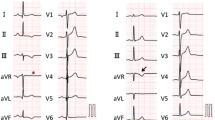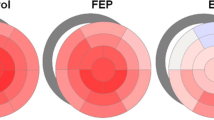Abstract
Fragmented QRS (fQRS) on a 12-lead electrocardiogram is a known marker of fatal arrhythmias or cardiac adverse events in ischemic and non-ischemic cardiomyopathy patients. Nonetheless, the association between fQRS and clinical outcomes in patients with cardiac sarcoidosis (CS) remains unclear. Herein, we investigated whether fQRS is associated with long-term clinical outcomes in CS patients. A total of 78 patients who received immunosuppressive therapy (IST) for clinically diagnosed CS were retrospectively examined. Patients were classified into two groups according to the presence (n = 19) or absence (n = 59) of fQRS on electrocardiogram before IST. The primary outcome was the composite event of all-cause death, ventricular tachyarrhythmias (VTs), and hospitalization for heart failure. Results of late gadolinium enhancement on cardiac magnetic resonance imaging were also analyzed. During a median follow-up period of 3.7 years (interquartile range: 1.6–6.2 years), the primary outcome occurred more frequently in patients with fQRS than in those without (47% vs. 13%, log-rank p = 0.002). Multivariable Cox regression analyses showed that fQRS was an independent determinant of the primary outcome. The incidence of VTs, within 12 months of IST initiation, was comparable between the two groups; however, late-onset VTs, defined as those occurring ≥ 12 months after IST initiation, occurred more frequently in the fQRS group (21% vs. 2%, log-rank p = 0.002). The scar zone and scar border zone were greater in patients with fQRS than in those without it. In conclusion, our analysis suggests that fQRS is an independent predictor of adverse events, particularly late-onset VTs, in patients with CS.







Similar content being viewed by others
Data availability
The data underlying this article cannot be shared publicly due to the privacy of individuals that participated in the study. The data will be shared on reasonable request to the corresponding author.
References
Iannuzzi MC, Rybicki BA, Teirstein AS (2007) Sarcoidosis. N Engl J Med 357:2153–2165
Koiwa H, Tsujino I, Ohira H, Yoshinaga K, Otsuka N, Nishimura M (2010) Images in cardiovascular medicine: imaging of cardiac sarcoid lesions using fasting cardiac 18F-fluorodeoxyglucose positron emission tomography: an autopsy case. Circulation 122:535–536
Carey VJ, Walters EE, Colditz GA, Solomon CG, Willett WC, Rosner BA, Speizer FE, Manson JE (1997) Body fat distribution and risk of non-insulin-dependent diabetes mellitus in women. The Nurses’ Health Study. Am J Epidemiol 145:614–619
Naruse Y, Sekiguchi Y, Nogami A, Okada H, Yamauchi Y, Machino T, Kuroki K, Ito Y, Yamasaki H, Igarashi M, Tada H, Nitta J, Xu D, Sato A, Aonuma K (2014) Systematic treatment approach to ventricular tachycardia in cardiac sarcoidosis. Circ Arrhythm Electrophysiol 7:407–413
Kumar S, Barbhaiya C, Nagashima K, Choi EK, Epstein LM, John RM, Maytin M, Albert CM, Miller AL, Koplan BA, Michaud GF, Tedrow UB, Stevenson WG (2015) Ventricular tachycardia in cardiac sarcoidosis: characterization of ventricular substrate and outcomes of catheter ablation. Circ Arrhythm Electrophysiol 8:87–93
Segawa M, Fukuda K, Nakano M, Kondo M, Satake H, Hirano M, Shimokawa H (2016) Time course and factors correlating with ventricular tachyarrhythmias after introduction of steroid therapy in cardiac sarcoidosis. Circ Arrhythm Electrophysiol 9:e003353
Das MK, Khan B, Jacob S, Kumar A, Mahenthiran J (2006) Significance of a fragmented QRS complex versus a Q wave in patients with coronary artery disease. Circulation 113:2495–2501
Das MK, Suradi H, Maskoun W, Michael MA, Shen C, Peng J, Dandamudi G, Mahenthiran J (2008) Fragmented wide QRS on a 12-lead ECG: a sign of myocardial scar and poor prognosis. Circ Arrhythm Electrophysiol 1:258–268
Morita H, Kusano KF, Miura D, Nagase S, Nakamura K, Morita ST, Ohe T, Zipes DP, Wu J (2008) Fragmented QRS as a marker of conduction abnormality and a predictor of prognosis of Brugada syndrome. Circulation 118:1697–1704
Das MK, Maskoun W, Shen C, Michael MA, Suradi H, Desai M, Subbarao R, Bhakta D (2010) Fragmented QRS on twelve-lead electrocardiogram predicts arrhythmic events in patients with ischemic and nonischemic cardiomyopathy. Heart Rhythm 7:74–80
Das MK, Saha C, El Masry H, Peng J, Dandamudi G, Mahenthiran J, McHenry P, Zipes DP (2007) Fragmented QRS on a 12-lead ECG: a predictor of mortality and cardiac events in patients with coronary artery disease. Heart Rhythm 4:1385–1392
Homsi M, Alsayed L, Safadi B, Mahenthiran J, Das MK (2009) Fragmented QRS complexes on 12-lead ECG: a marker of cardiac sarcoidosis as detected by gadolinium cardiac magnetic resonance imaging. Ann Noninvasive Electrocardiol 14:319–326
Terasaki F, Azuma A, Anzai T, Ishizaka N, Ishida Y, Isobe M, Inomata T, Ishibashi-Ueda H, Eishi Y, Kitakaze M, Kusano K, Sakata Y, Shijubo N, Tsuchida A, Tsutsui H, Nakajima T, Nakatani S, Horii T, Yazaki Y, Yamaguchi E, Yamaguchi T, Ide T, Okamura H, Kato Y, Goya M, Sakakibara M, Soejima K, Nagai T, Nakamura H, Noda T, Hasegawa T, Morita H, Ohe T, Kihara Y, Saito Y, Sugiyama Y, Morimoto SI, Yamashina A (2019) JCS 2016 guideline on diagnosis and treatment of cardiac sarcoidosis- digest version. Circ J 83:2329–2388
Sato T, Tsujino I, Ohira H, Oyama-Manabe N, Ito YM, Noguchi T, Yamada A, Ikeda D, Watanabe T, Nishimura M (2013) Paradoxical interventricular septal motion as a major determinant of late gadolinium enhancement in ventricular insertion points in pulmonary hypertension. PLoS ONE 8:e66724
Oyama-Manabe N, Ishimori N, Sugimori H, Van Cauteren M, Kudo K, Manabe O, Okuaki T, Kamishima T, Ito YM, Tsutsui H, Tha KK, Terae S, Shirato H (2011) Identification and further differentiation of subendocardial and transmural myocardial infarction by fast strain-encoded (SENC) magnetic resonance imaging at 3.0 tesla. Eur Radiol 21:2362–2368
Ise T, Hasegawa T, Morita Y, Yamada N, Funada A, Takahama H, Amaki M, Kanzaki H, Okamura H, Kamakura S, Shimizu W, Anzai T, Kitakaze M (2014) Extensive late gadolinium enhancement on cardiovascular magnetic resonance predicts adverse outcomes and lack of improvement in LV function after steroid therapy in cardiac sarcoidosis. Heart 100:1165–1172
Sonoda K, Okumura Y, Watanabe I, Nagashima K, Mano H, Kogawa R, Yamaguchi N, Takahashi K, Iso K, Ohkubo K, Nakai T, Kunimoto S, Hirayama A (2017) Scar characteristics derived from two- and three-dimensional reconstructions of cardiac contrast-enhanced magnetic resonance images: relationship to ventricular tachycardia inducibility and ablation success. J Arrhythm 33:447–454
Lang RM, Badano LP, Mor-Avi V, Afilalo J, Armstrong A, Ernande L, Flachskampf FA, Foster E, Goldstein SA, Kuznetsova T, Lancellotti P, Muraru D, Picard MH, Rietzschel ER, Rudski L, Spencer KT, Tsang W, Voigt JU (2015) Recommendations for cardiac chamber quantification by echocardiography in adults: an update from the American Society of Echocardiography and the European Association of Cardiovascular Imaging. J Am Soc Echocardiogr 28:1-39.e14
Cacoub P, Chapelon-Abric C, Resche-Rigon M, Saadoun D, Desbois AC, Biard L (2020) Cardiac sarcoidosis: a long term follow up study. PLoS ONE 15:e0238391
Breithardt G, Cain ME, El-Sherif N, Flowers NC, Hombach V, Janse M, Simson MB, Steinbeck G (1991) Standards for analysis of ventricular late potentials using high-resolution or signal-averaged electrocardiography. A statement by a Task Force Committee of the European Society of Cardiology, the American Heart Association, and the American College of Cardiology. Circulation 83:1481–1488
Gomes JA, Cain ME, Buxton AE, Josephson ME, Lee KL, Hafley GE (2001) Prediction of long-term outcomes by signal-averaged electrocardiography in patients with unsustained ventricular tachycardia, coronary artery disease, and left ventricular dysfunction. Circulation 104:436–441
Das MK, Michael MA, Suradi H, Peng J, Sinha A, Shen C, Mahenthiran J, Kovacs RJ (2009) Usefulness of fragmented QRS on a 12-lead electrocardiogram in acute coronary syndrome for predicting mortality. Am J Cardiol 104:1631–1637
Kang KW, Janardhan AH, Jung KT, Lee HS, Lee MH, Hwang HJ (2014) Fragmented QRS as a candidate marker for high-risk assessment in hypertrophic cardiomyopathy. Heart Rhythm 11:1433–1440
Xu Y, Yu Y, He L, Wang Y, Gu Y (2021) Predicting efficacy of combined assessment with fragmented QRS and severely depressed heart rate variability on outcome of patients with acute myocardial infarction. Heart Vessels 37:239–249
Betensky BP, Tschabrunn CM, Zado ES, Goldberg LR, Marchlinski FE, Garcia FC, Cooper JM (2012) Long-term follow-up of patients with cardiac sarcoidosis and implantable cardioverter-defibrillators. Heart Rhythm 9:884–891
Al-Khatib SM, Stevenson WG, Ackerman MJ, Bryant WJ, Callans DJ, Curtis AB, Deal BJ, Dickfeld T, Field ME, Fonarow GC, Gillis AM, Granger CB, Hammill SC, Hlatky MA, Joglar JA, Kay GN, Matlock DD, Myerburg RJ, Page RL (2018) 2017 AHA/ACC/HRS guideline for management of patients with ventricular arrhythmias and the prevention of sudden cardiac death: a report of the American College of Cardiology/American Heart Association Task Force on Clinical Practice Guidelines and the Heart Rhythm Society. J Am Coll Cardiol 72:e91–e220
Yodogawa K, Seino Y, Shiomura R, Takahashi K, Tsuboi I, Uetake S, Hayashi H, Horie T, Iwasaki YK, Hayashi M, Miyauchi Y, Shimizu W (2013) Recovery of atrioventricular block following steroid therapy in patients with cardiac sarcoidosis. J Cardiol 62:320–325
Yodogawa K, Fujimoto Y, Hagiwara K, Oka E, Hayashi H, Murata H, Yamamoto T, Iwasaki Y, Shimizu W (2022) Possibility of steroid therapy without pacemaker implantation in patients with sarcoidosis presenting atrioventricular block. Heart Vessels 37:1892–1898
Coleman GC, Shaw PW, Balfour PC Jr, Gonzalez JA, Kramer CM, Patel AR, Salerno M (2017) Prognostic value of myocardial scarring on CMR in patients with cardiac sarcoidosis. JACC Cardiovasc Imaging 10:411–420
Kusano K, Ishibashi K, Noda T, Nakajima K, Nakasuka K, Terasaki S, Hattori Y, Nagayama T, Mori K, Takaya Y, Miyamoto K, Nagase S, Aiba T, Yasuda S, Kitakaze M, Kamakura S, Yazaki Y, Morimoto S, Isobe M, Terasaki F (2021) Prognosis and outcomes of clinically diagnosed cardiac sarcoidosis without positive endomyocardial biopsy findings. JACC Asia 7:385–395
Yazaki Y, Isobe M, Hiroe M, Morimoto S, Hiramitsu S, Nakano T, Izumi T, Sekiguchi M (2001) Prognostic determinants of long-term survival in Japanese patients with cardiac sarcoidosis treated with prednisone. Am J Cardiol 88:1006–1010
Nabeta T, Kitai T, Naruse Y, Taniguchi T, Yohshioka K, Tanaka H, Okumura T, Sato S, Baba Y, Kida K, Tamaki Y, Matsumoto S, Matue Y (2022) Risk stratification of patients with cardiac sarcoidosis: the ILLUMINATE-CS registry. Eur Heart J 43:3450–3459
Ueda N, Noda T, Ideshi A, Wada M, Yamagata K, Ishibashi K, Yuko I, Miyamoto K, Yasuda S, Kusano K (2022) Clinical impacts and insights into mechanisms of paced fragmented QRS in cardiac resynchronization therapy patients. JACC Clin Electrophysiol 8:681–684
Acknowledgements
The authors wish to thank all the investigators, clinical research coordinators, and data managers for their contributions. We would like to thank Mr. John Martin for English language editing.
Author information
Authors and Affiliations
Corresponding author
Ethics declarations
Conflict of interest
The authors declare that they have no conflict of interest.
Additional information
Publisher's Note
Springer Nature remains neutral with regard to jurisdictional claims in published maps and institutional affiliations.
Rights and permissions
Springer Nature or its licensor (e.g. a society or other partner) holds exclusive rights to this article under a publishing agreement with the author(s) or other rightsholder(s); author self-archiving of the accepted manuscript version of this article is solely governed by the terms of such publishing agreement and applicable law.
About this article
Cite this article
Hagiwara, H., Watanabe, M., Kadosaka, T. et al. Fragmented QRS on 12-lead electrocardiogram predicts long-term prognosis in patients with cardiac sarcoidosis. Heart Vessels 38, 803–816 (2023). https://doi.org/10.1007/s00380-022-02229-2
Received:
Accepted:
Published:
Issue Date:
DOI: https://doi.org/10.1007/s00380-022-02229-2




